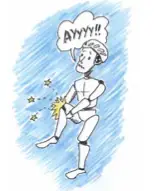Those of you who have been following our Technique Tuesdays may be already committed to gravel or road racing during the season. Others may be beginning to train for running specifically for cyclocross. With all of these activities that change the pace from what you may be used to, you may find parts of your body more sore lately. This article originally appeared in Issue 23 of Cyclocross Magazine and talks about injury and how you can avoid it, simply. You can read the full article by ordering your backcopy today, which is also available on Uberflip, in the App Store on iTunes, and on Google Play for Android.
by Ian McMahan
It starts with a little ache in your knee after that first dusty race in September, then progresses to pain during the weekly early morning interval workout and finally builds to the point you’re walking down stairs like you’ve just aged 30 years.
Sound familiar? We’ve all been there, and we all handle it differently. Some of us curse a lot and sulk on race days when our injuries sideline us or cause that dreaded DNF. Others turn to every doctor, specialist or homeopathic healer possible looking for a solution. But wouldn’t it be great if we could just avoid injury altogether? Or, barring that, at least catch it before it gets too extreme?
Cyclocross injuries occur in two different ways: collisions with unyielding objects such as the ground or fellow racers and the general wear and tear of training and racing. This ar- ticle can’t help you avoid the ending your race in a cloud of dust, but it will help you avoid the overuse injuries that can be common to cyclocross (and all types of cycling).
First a general word about injury. Overuse injuries are common among cyclists (50 percent of cyclists experience an overuse injury in a given year) and unless ignored, usually don’t require extended time off the bike. Note the part about not ignoring the little tweaks and pains! Although there isn’t any way to fully prevent injuries, combining smart training with some preventative maintenance improves your chances of finishing your season healthy.
While this advice may come too late to save you this season, it shouldn’t be a surprise that going from the summer activities of sitting on the couch and long naps in the afternoon directly to all-out cyclocross racing in the fall and winter is inviting injury. While this does help your local sports medicine professionals put food on their table, avoiding injury starts with a smart buildup to the ’cross season.
Avoiding Injury
While pre-exercise static stretching has been questioned as an effective tool for injury prevention and performance, dynamic stretching can be valuable before exercise. Dynamic stretching uses controlled movements to actively move the muscle into a stretched position. The result is an improvement in range of motion without the performance loss associated with traditional static stretching. Dynamic stretching will be most effective when the stretches are cyclocross-specific.
As a rule, cyclocross (and most endurance athletes) aficionados rate going to the gym and lifting weights on the same level as root canals and Justin Bieber songs. However, as past articles [See Issue 20 of Cyclocross Magazine] have stated, resistance training is a valuable piece of performance training and good orthopedic health. Strong muscles protect joints, tendons and ligaments and make the body more resistant to the repeated stresses of cyclocross.
Kneecap/Patella Pain
The knee is the most common site of overuse injuries in cyclists and if you’re a grizzled veteran of the cyclocross circuit, chances are you’ve experienced kneecap soreness or pain at some point. The condition is characterized by pain going down stairs, pain when sitting with the knee bent for long periods or, saddest of all, pain when pushing big gears on a bike.
Kneecap pain, known as patellofemoral pain, is caused by irritation of the underside of the patella against the leg bone or femur under- neath. While in more severe or chronic cases, the patella’s protective cartilage may become worn away and create more long-term problems, patellar pain does not usually indicate arthritis and can usually be resolved.
Problem: Pain in or around the kneecap/patella, popping, cracking
Cause: Going from couch to ’cross without enough prep and pushing big gears/low cadence (less than 60 rpm). Poor bike fit can also be a culprit.
Off The Bike Fix: Strengthening the quads and outer hip muscles can help prevent and treat patellofemoral pain.
On The Bike Fix: Make sure seat is not too low or too far forward, and seriously consider getting a bike fit. Additionally, practice riding with a higher cadence.
See A Doctor If: The pain starts to significantly affect daily life or limits training.
To see the fixes for back pain, groin pain and more, make sure you pick up an archived copy!





























